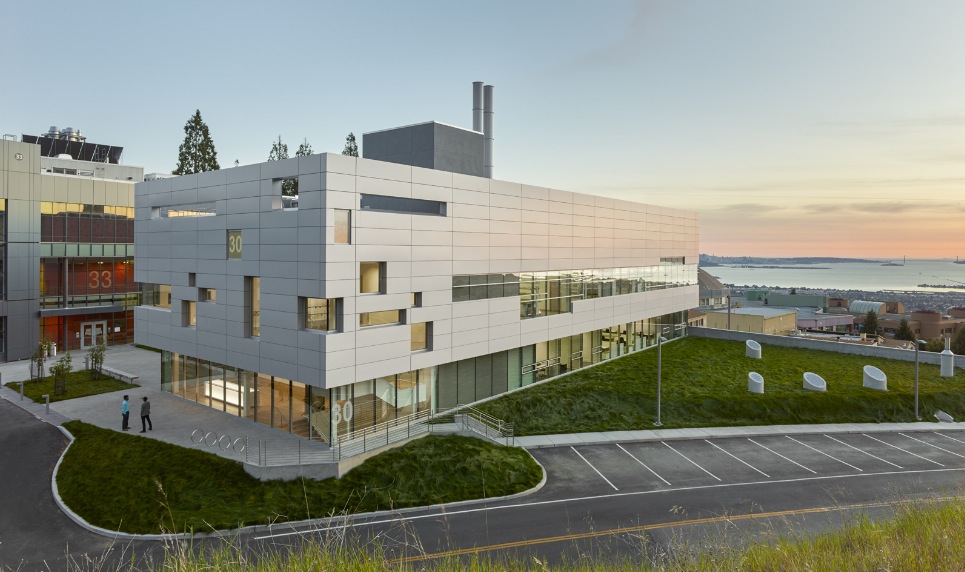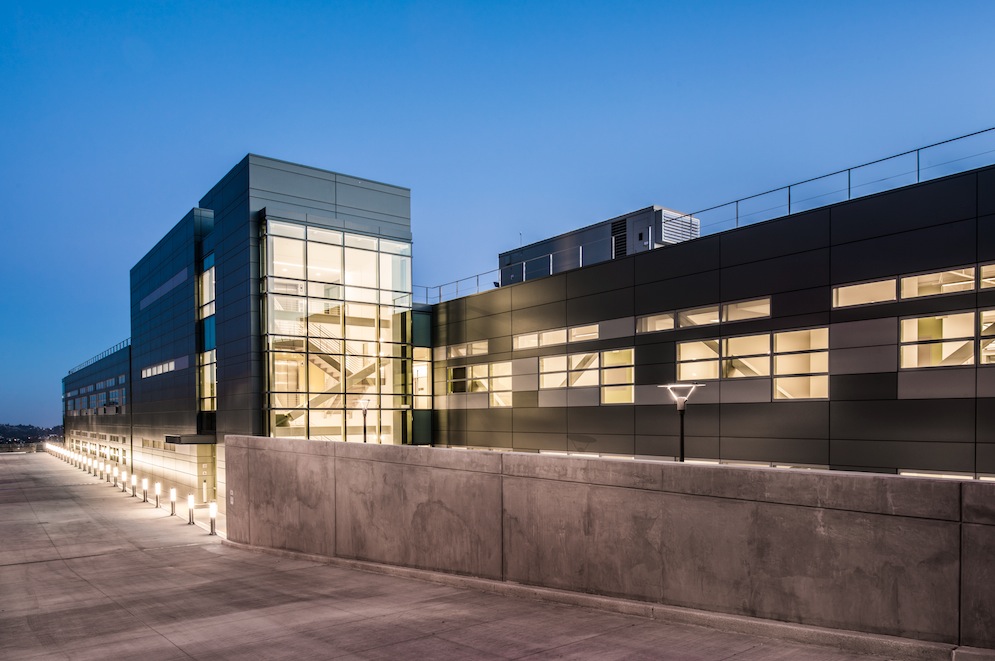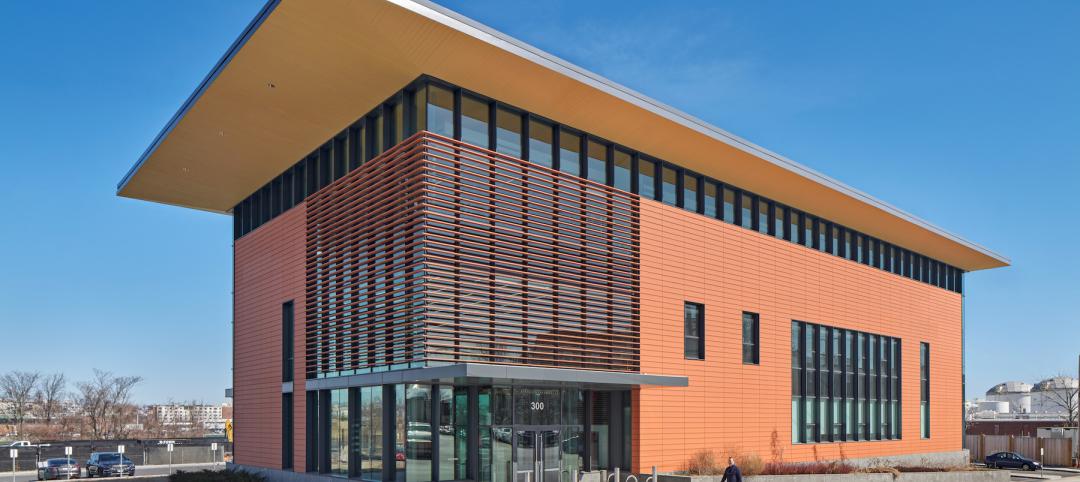Engineering firm Burns & McDonnell is converting a shuttered medical center in Independence, Mo., to a central utility plaza that will unite the city’s water, electric, and wastewater administrative and customer services under one roof. The city’s Department of Power & Light intends to use the building as a public education and outreach showcase for sustainable best practices.
Upon completion next September, the 45,000-sf renovated building will start reducing its annual energy costs by 55% with high-efficiency LED lighting and upgraded HVAC systems and controls. Water usage will be cut by 40%. A rooftop solar array and wind turbine are expected to generate 13% of the three-story building’s electricity needs, says Leon Daggett, the utility department’s director.
The $8.9 million project, which is pursuing LEED Platinum certification, will have six electric vehicle chargers. The renovation will retain 95% of the existing structure and divert 75% of C&D waste from landfill.
Government projects like this are no longer the exception, particularly at the federal level. For its recently completed $59 million Solar Energy Research Center at Lawrence Berkeley National Laboratory, the Department of Energy instructed its Building Team—led by SmithGroupJJR (architect and master planner) and McCarthy Building Companies (general contractor)—to create carbon-neutral sources of energy.
Known as Chu Hall, the 39,000-sf center’s renewable energy sources include solar hot water panels and PV arrays. Passive energy features include a heat-recovery system, high-efficiency condensing boilers and chillers with variable frequency drives, an evaporative pre-cooling hybrid system, and individual terminals that signal when a window on an office floor is open.
A recent military project led by design firm Leo A Daly—the 577,988-sf, $410 million Irwin Army Community Hospital Replacement Facility, at Fort Riley, Kan.—achieved LEED Silver certification. “Federal healthcare clients are interested in pursuing energy reductions from smart lifestyle cost-efficient decisions. They’re not interested in science projects,” quips Rich Onken, AIA, EDAC, Senior Project Manager. He says energy modeling has become invaluable for determining life cycle costs for federal projects.
Leo A Daly is finding that state government clients are also stepping up to the challenge, says Cindy McCleary, AIA, NCARB, LEED AP, Market Sector Leader–Regional Government for the firm’s Minneapolis office. She notes that projects for the state of Minnesota and the Minnesota State Colleges and Universities must now achieve 70% better than code-minimum energy use on new projects. The state’s goal: 100% carbon neutrality by 2030.
 Skidmore, Owings & Merrill and Rensselaer Polytechnic Institute co-developed an “active modular phytoremediation” system, which filters indoor air through a wall of hydroponic plants to detoxify the air. The system was installed at the Public Safety Answering Center II in the Bronx, N.Y. “This takes the concept of ferns in offices and multiplies it by 200,” says Nicholas Holt, AIA, LEED AP BD+C, a Director in SOM’s New York office. Image courtesy SOM.
Skidmore, Owings & Merrill and Rensselaer Polytechnic Institute co-developed an “active modular phytoremediation” system, which filters indoor air through a wall of hydroponic plants to detoxify the air. The system was installed at the Public Safety Answering Center II in the Bronx, N.Y. “This takes the concept of ferns in offices and multiplies it by 200,” says Nicholas Holt, AIA, LEED AP BD+C, a Director in SOM’s New York office. Image courtesy SOM.
Nicos Katsellis, RA, LEED AP BD+C, EDAC, GGP, Director of Operations for Leo A Daly’s Los Angeles office, says that, as energy-efficiency and sustainability standards keep ratcheting up, early collaboration among team members helps set priorities to develop holistic solutions.
Scott Lawson, Vice President for Clark Construction, in Los Angeles, couldn’t agree more. “Gathering the Building Team early is absolutely essential to understanding what the client wants and formulating a strategy,” he says. He points to the 545,000-sf Governor George Deukmejian Courthouse, in Long Beach, Calif., a LEED Gold building that opened in 2013. Lawson says that Johnson Controls, which will manage the building for 35 years, was willing to approve certain higher-cost products—like LED lighting instead of CFLs, and terrazzo flooring instead of carpeting—based on their long-term maintenance and sustainability.
The project’s unique performance-based infrastructure contract guarantees that the courthouse will be usable and functional for its intended purposes. Otherwise, the state, which owns the building but paid no upfront construction costs, will receive discounts on its annual payments to a consortium that includes Clark’s design-build subsidiary, AECOM, Johnson Controls, and the developer, Long Beach Judicial Partners.
NAVIGATING GOVERNMENT REGULATORY AND BUDGETARY CONSTRAINTS
Government work can also be a puzzle for AEC firms. Federal projects are subject to budgets and mandates that can work sometimes against sustainable design. Skidmore, Owings & Merrill recently completed the Air Force Academy’s Center for Character and Leadership Development. The building had been designed for LEED Platinum but was scaled back to LEED Silver because Congress at the time prohibited any Department of Defense construction to exceed that level, according to SOM’s Nicholas Holt, AIA, LEED AP BD+C.
A DOE project, the 139,800-sf Computational and Research Theory Facility at the University of California, Berkeley, is situated on a fault line, with its broadest elevation facing west—not exactly optimal for daylighting or solar power. Designer Perkins+Will addressed this problem by specifying a solar shading system that operates from noon to 3 p.m., says P+W Architect Kase Macosko. The building uses natural air to cool the data center’s supercomputers. Macosko says P+W and engineer Thornton Tomasetti focused on minimizing the amount of energy used to run the computers.
 Solar Energy Research Center at Lawrence Berkeley National Laboratory. Image courtesy SmithGroupJJR.
Solar Energy Research Center at Lawrence Berkeley National Laboratory. Image courtesy SmithGroupJJR.
Related Stories
Government Buildings | Jun 16, 2023
A police station in Boston attempts to bridge the divide separating law enforcement and the public
An investment in workers and residents, the new building is also more efficient and sustainable.
Engineers | Jun 14, 2023
The high cost of low maintenance
Walter P Moore’s Javier Balma, PhD, PE, SE, and Webb Wright, PE, identify the primary causes of engineering failures, define proactive versus reactive maintenance, recognize the reasons for deferred maintenance, and identify the financial and safety risks related to deferred maintenance.
Government Buildings | May 18, 2023
GSA launches first biennial construction award program
Today, the U.S. General Services Administration (GSA) announced the new biennial GSA Construction Award program, which is seeking submissions this summer. The program was created to honor outstanding achievements in construction, with a focus on quality and craftsmanship, collaboration and team dynamics, sustainability, innovation, and technology. The first Construction Awards ceremony will take place in 2024.
Mass Timber | May 1, 2023
SOM designs mass timber climate solutions center on Governors Island, anchored by Stony Brook University
Governors Island in New York Harbor will be home to a new climate-solutions center called The New York Climate Exchange. Designed by Skidmore, Owings & Merrill (SOM), The Exchange will develop and deploy solutions to the global climate crisis while also acting as a regional hub for the green economy. New York’s Stony Brook University will serve as the center’s anchor institution.
Urban Planning | Apr 12, 2023
Watch: Trends in urban design for 2023, with James Corner Field Operations
Isabel Castilla, a Principal Designer with the landscape architecture firm James Corner Field Operations, discusses recent changes in clients' priorities about urban design, with a focus on her firm's recent projects.
Market Data | Apr 11, 2023
Construction crane count reaches all-time high in Q1 2023
Toronto, Seattle, Los Angeles, and Denver top the list of U.S/Canadian cities with the greatest number of fixed cranes on construction sites, according to Rider Levett Bucknall's RLB Crane Index for North America for Q1 2023.
Contractors | Apr 10, 2023
What makes prefabrication work? Factors every construction project should consider
There are many factors requiring careful consideration when determining whether a project is a good fit for prefabrication. JE Dunn’s Brian Burkett breaks down the most important considerations.
Architects | Apr 6, 2023
New tool from Perkins&Will will make public health data more accessible to designers and architects
Called PRECEDE, the dashboard is an open-source tool developed by Perkins&Will that draws on federal data to identify and assess community health priorities within the U.S. by location. The firm was recently awarded a $30,000 ASID Foundation Grant to enhance the tool.
Sustainability | Apr 4, 2023
NIBS report: Decarbonizing the U.S. building sector will require massive, coordinated effort
Decarbonizing the building sector will require a massive, strategic, and coordinated effort by the public and private sectors, according to a report by the National Institute of Building Sciences (NIBS).
Government Buildings | Mar 24, 2023
19 federal buildings named GSA Design Awards winners
After a six-year hiatus, the U.S. General Services Administration late last year resumed its esteemed GSA Design Awards program. In all, 19 federal building projects nationwide were honored with 2022 GSA Design Awards, eight with Honor Awards and 11 with Citations.
















